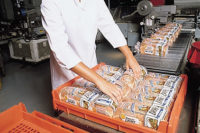Most bakers and snack producers recognize that a solid food-safety program is about managing the quality of a system. As a result, the emphasis of today’s programs is as much on validation and verification of food-handling practices as it is on cleaning and sanitation. With the new federal regulations, the future of food-safety initiatives and practices will place the responsibility for food safety squarely on the shoulders of food manufacturers.
Food manufacturers also must pay closer attention to their suppliers, as well as conduct more comprehensive audits, to ensure the food-safety procedures put in place are properly followed. “The importance of keeping and validating food-safety records can be compared to the significance of making sure our financial records are as accurate as possible for the IRS,” says Brian Dunning, director of corporate quality assurance at Blue Diamond Global Ingredients, Sacramento, Calif. “The investment into third-party certification will soon be the cost of doing business and an investment in maintaining a quality management system.”
When it is fully implemented, the U.S. Food and Drug Administration’s (FDA) Food Safety Modernization Act (FSMA) will require the entire food industry to look at every food item produced, to identify reasonable foreseeable hazards and to develop effective controls to ensure prevention of food-borne illnesses or injuries.
The issues
Complying with federal requirements may not always provide a food processor with immunity in terms of following regulations. “For example, the state of California has a different set of food-safety standards than does the FDA,” says Nicholas Pyle, president of the Independent Bakers Association (IBA), Washington. “[Bakeries and snack producers] have to be on top of their game to fulfill all organizations’ guidelines and requirements.”
Although bakery products and snack foods have had a relatively clean history in terms of food safety, there recently have been problems related to microbial-contaminated ingredients added after the thermal process step.
“This resulted in a number of illnesses and caused a great deal of concern from public health officials and the food industry,” says Gale Prince, founder and president of SAGE Food Safety Consultants, LLC, and contributing food-safety writer for Snack Food & Wholesale Bakery. “The common element was due to the microbiological contamination of nut products and seasonings materials that affected ready-to-eat snack products. This drove the bakery and snack food industry to look more closely at their products, processes and ingredient suppliers’ food-safety programs.”
While thermal treatment of baked goods and snack products is a common control step to prevent microbiological contamination, the environment within which these products are processed can harbor post-process contamination, Prince says. “Microbes are hitchhikers and can be reintroduced after thermal processing via equipment, utensils, added ingredients, packaging materials or people,” he explains. “Process flow and employee traffic patterns within the plant need to be addressed to prevent the opportunity for cross contamination from raw to finished products.”
Controlling microbes is more difficult when production equipment isn’t designed for the level of cleanability and sanitation now required. This is because bacteria can thrive in small cracks and crevices.
Addressing this issue, the American Bakers Association (ABA), Washington, has partnered with a half-dozen other industry organizations to run workshops that emphasize the importance of sanitary design. “One of the things that can be done right out of the box is not only improve sanitary practices, but also look at the techniques for sanitary equipment design,” says Robb MacKie, president and CEO of ABA. “[These workshops] get down to the nuts and bolts of designing equipment with fewer catch surfaces.”
ABA works with the Bakery Equipment Manufacturers and Allieds (BEMA), Overland Park, Kan., and the American Institute of Baking (AIB) International, Manhattan, Kan., to review practices and also to rewrite the Baking Industry Sanitation Standards Committee’s (BISSC) sanitation standards to better comply with today’s requirements. “Although equipment manufacturers used to build things according to BISSC standards, the standards have lost relevancy over the years,” MacKie says. “We have worked with industry organizations to substantially upgrade it. As a result, there have been more than 300 changes to help modernize these standards.”
In addition to raising the bar on equipment standards, there is an increased focus on allergens and salmonella in the snack and baked goods industries. “Most snack food and baked goods manufacturers are handling a variety of allergens, and as we see from our Class I Recall data, mislabeling issues are common,” says Stephanie Lopez, vice president, food safety education at AIB International. “Salmonella is also now better recognized for its ability to survive in low-moisture foods, which is significantly changing how pathogen control is viewed in the baking and snack food industries.”
FSMA’s impact
The implementation of FSMA will have a big impact on food manufacturers’ production practices. “FSMA will require all bakery and snack food facilities to prepare a written food-safety plan that identifies all hazards that are likely to occur with ingredients and processing of bakery and snack food products,” Prince explains. These hazards include microbiological, chemical and physical risks that could occur with ingredients and products.
“In addition, each facility will have to develop preventative controls that will address each of the hazards identified,” he continues. “The established preventative controls will have to show scientific and technical information to demonstrate that they will effectively monitor the identified hazards. Under FSMA, each facility shall have in place a system to verify that preventative controls are being followed with each production run. These records are assessable by the regulatory agency when they have reason to believe that a product could be contaminated. The only exemption to these requirements will be extremely small operators with a very limited, local distribution directly to consumers.”
On Jan. 4, 2013, the FDA issued two major proposed FSMA rules regarding preventative controls in human food and produce safety. The proposed rule for the former applies to facilities that manufacture, process, pack or hold human food. The new provisions would apply to most facilities required to register with FDA under its current food facility registration regulations. The rule proposes that companies have written plans in place to identify potential hazards, put in place steps to address them, verify that the steps are working and outline how to correct any problems that arise. Each facility will be required to prepare and implement a written food-safety plan that includes hazard analysis, risk-based preventive controls, monitoring procedures, corrective actions, verification and recordkeeping.
The proposed standards for produce safety covers all fruits and vegetables, except those rarely consumed raw, produced for personal consumption or destined for commercial processing that will reduce microorganisms of public health concern. The proposed rule focuses on areas of risk, including agricultural water, biological soil amendments, health and hygiene, domesticated and wild animals, and equipment, tools and buildings.
“Although FSMA will drive many of the changes for the next year, it’s important to note that the FDA has been delayed in rolling out the compliance and enforcement provisions that were authorized under the legislation,” MacKie points out. “We anticipate in the first half of the year, we will see aspects of this act unveiled.”
FSMA compliance
Bakers and snack manufacturers need to be aware of two major FSMA compliance issues. The first involves registration fees.
“The original legislation called for close to a quarter million dollars in registration fees from food companies,” MacKie says. “We worked with key senators to make sure the final bill did not include these fees, but in the last two budget proposals, the net revenue from those fees was included.” This means that a medium-sized baker will be required to pay the federal government $185,000 in registration fees annually.
Good manufacturing practices also can be a challenge for bakers and snack producers that not only manufacture fresh product, but also use an extensive distribution system.
“One of the concerns we had is, while it’s appropriate to have provisions for manufacturers in regard to good manufacturing practices, it can become more challenging to have a full regime of control plans when other warehouses are involved,” MacKie explains. “Consequently, we have been working with the FDA to obtain an exemption for distribution warehouses used for short-term holding of nonperishable product that propose no food-safety risks.”
Other FSMA issues that still have to be resolved include the verification of foreign suppliers of ingredients. “Many food industry ingredients originate from foreign sources, and some are more challenging to deal with than others,” MacKie says. “The bottom line is that we need to ensure that food is safe without there being a huge bureaucratic hassle to make that happen.”
Under FSMA, what have been best practices in the industry and are often customer-driven are now becoming regulation. “Manufacturers who have taken responsibility for food safety and have had robust programs, such as food defense and Hazard Analysis Critical Control Points (HACCP), will not see much changing from a requirements standpoint,” Lopez says. “For those companies that have not been proactive in adopting robust preventive programs, there will likely be a steep learning curve that may ultimately lead to voluntary or mandated business closures.”
Many in the industry also predict that, with the new authorities given to the federal government, FDA investigations will be more rigorous, and there will be more opportunity for violations to be identified through documentation. “The threshold for FDA investigators to review documentation has been lowered in many instances,” Lopez says. “Documentation that doesn’t clearly demonstrate that food-safety programs have been fully implemented and validated will likely lead to further action, including re-inspection and up to suspension of registration.”
Recent developments
As a result of more comprehensive and stringent food-safety requirements, industry organizations are assisting bakers and snack producers with compliance information and assistance. AIB International has received more requests from bakeries and snack manufacturers to assist with establishing an appropriate environmental monitoring program and helping conduct kill-step validation studies.
To provide educational opportunities for its members, IBA has sponsored sanitation seminars on allergen and pathogen control. “All of our members are looking at FSMA when designing equipment,” Pyle says. “Many have brought in bakers to help them find another angle or material to enhance equipments’ cleanability. With all of the additional testing, equipment manufacturers have become dedicated to designs that have zero tolerance for harboring allergens and pathogens.”
The importance of FSMA has hit home with most food manufacturers, including Blue Diamond Global Ingredients, which recently designed a new manufacturing facility that focuses on hygiene principles. “In the past, our equipment was not particularly hygiene-focused, but this is now a primary factor in our investments today,” Dunning says. “Sanitation principles have changed dramatically in just a few years.”
In addition, with the elevated authority of FDA documentation, food-safety records are more important than ever. The bakery and snack food industry, as well as the rest of the food industry, has been the focus of the Global Food Safety Initiative (GFSI), which requires written food-safety plans and third-party audits of production facilities.
“This has raised the attention of food safety throughout the food industry,” Prince notes. “GFSI is a preparatory step to the requirements of FSMA.”
Although it is human nature to accept the status quo, recent food-borne illnesses and numerous product recalls have demonstrated the economic importance of companies to examine their product lines from a food-safety standpoint. “FSMA will require companies to conduct an even deeper look at the sanitary design of facilities and equipment as well as their processes and their ingredient supply chain to achieve food-safety requirements,” Prince adds.
This includes regular and thorough audits, which manufacturers should consider a valuable long- and short-range tool. “If an audit isn’t factual, it can provide manufacturers with a false sense of security,” says Gary Ades, president of G&L Consulting Group, Bentonville, Ark., and former director of food safety and security for Sam’s Club, Bentonville, Ark. “It’s important to look at the tools and metrics being used to confirm that the audits are accurate.”
Ades says the top concerns to address are cross contamination leading to salmonella, allergen control and pest prevention. “Most recalls are caused by allergens, but in baking, it’s difficult to isolate ingredients,” he explains. “It’s necessary to run dedicated lines or have strict protocols for staging. Fortunately, there are allergen test kits available, so manufacturers have ways of conducting faster microbial checks.”
As food-safety requirements constantly change, new technology is making it easier for epidemiologists to detect and link microbial contamination of food products through DNA technology, computer analysis and electronic communication. “New diagnostic techniques can be expected to identify more food-borne illness cases much quicker than in the past, further emphasizing the need for the food industry to look at the design of their food-safety preventative measures to achieve results in preventing food-borne illnesses,” Prince says.
Under new federal regulations, manufacturers will be responsible for demonstrating that qualified individuals have developed effective food-safety programs and provide solid evidence that validates the effectiveness of these programs. “This isn’t only a requirement to produce safe food, but doing so in a proactive manner in which the burden of proof is on the manufacturer,” says Lopez. “I believe it will be similar to a ‘guilty until proven innocent’ mentality. Given that each facility is unique, this will not likely be something that can be done by food sector category or a corporate office. It will need to be completed on a plant-by-plant and product-by-product basis.”








